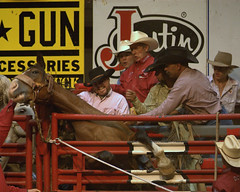When I write "Don't waste your money" I mean don't go for something cheap that "will do an OK job." THAT is wasting money. I know this from experience.
Like many people, I went to a discount store, browsed around and bought the typical cheap tripod, usually a video model with pan/tilt for less than a hundred dollars or so and felt like a pro. Now, it DID help steady the camera - as long as I was using small, light lenses and not paying attention to how the wind caused it to shake it a bit. It was better than hand-held but only marginally so.
Then as I got a bit better and more conscientious I thought I needed a better set up and went for a $200 tripod with a built-in ball head and added a $50 quick release. That lasted a while but still wasn't really as steady as it should be.
Another iteration of all of this - now spending maybe another $350 for a reasonably good travel weight/size tripod and head. This was actually working OK until I finally put a 300mm f/2.8 lens on my camera and tried to use that tripod. NO WAY it would hold it up and keep it steady.
So, where are we right now? Let's see - I've spent about $650 or so and still I don't have a tripod that works properly.
It's that $650 I want you not to waste. Here's what I recommend instead. Just go ahead and get the RIGHT tripod, ball-head and quick release up front; before you waste the $650; before you finally come to the conclusion that to do this photography thing right you really DO need that pro-level tripod. Do it right up front. Spend your money wisely instead and you'll never look back.
Here's what I recommend: (2007 prices and models)
- Gitzo GT3540LS Carbon Fiber 6X tripod - $650
- Really Right Stuff BH-55 LR ball head - $455
- Really Right Stuff L-bracket for your particular body - $140
This equipment will hold your camera and heavy lenses rock solid. Yes, it's heavier than a small travel tripod set-up but it's not so heavy that you can't hike with it. I do.
Stop and look around when you are at a spot with other photographers. Look at what the serious guys are using. Notice what looks like a really sturdy tripod. Odds are it will be similar to what I've described in my list. Ask them about what they're using. Get their advice and suggestions. That's what I did and made notes, came home and did my research on the net and selected the gear above.
NOTE: When you've settled on what seems right for you, take some measurements from your eye-level to the floor/ground while you are standing upright. Then measure the height of your camera from its baseplate to viewfinder. Next, look at the specs for the ball-head you've chosen and see how high it is. Add the ball-head height to the height of the camera from its baseplate to the view finder. Then subtract this total measurement from that eye-to-floor measurement you took. This will tell you how high your tripod should be when fully extended so that you don't have to stoop over to use it.
Bottom Line: Don't waste you money on a tripod; rather, spend it wisely on the right equipment. It will last for many years. And when you're ready to get the equipment you need, and if you're in North Texas, head over to Fort Worth Camera where you'll find the right gear, great support and good prices.



